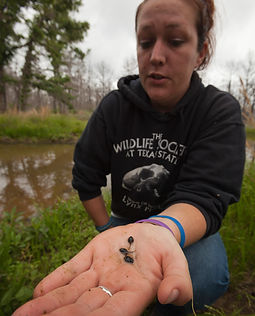
Toad in Trouble

Want to Read a Real Houston Toad Success Story?
Click HERE to meet Stumpy, our four-legged friend over at the Houston Zoo!
A Small Solution to Global Warming
Houston toads do more than just keeping their own ecosystem balanced; they play a pivotal role in aiding global warming one bite at a time. Greenhouse gases such as carbon dioxide gradually increase the temperature of the atmosphere (Pappas, 2017). Recently, many biomes have been experiencing rapid harm from global warming. Toads help combat this by consuming and capturing carbon before it is released. How? The answer is simple: eating invertebrates. More of Earth’s incredible species includes beetles and earthworms which are all common foods of the great Houston toad. These invertebrates would release carbon into the atmosphere by eating forest debris, such as fallen leaves, but amphibians save the day! However, dramatic negative outcomes will continue to rise as the toad population falls. To be clear, the species was listed endangered because there were less than 2,500 individuals. But that was in 1970, so the estimated population numbers of the species today is sadly less than a mere 300 (TPWD, 2016). Without your help, that number will keep shrinking, having a greater effect on all global biomes.

Amphibians, especially toads, have been around for millions of years, making them a great vessel for science and biology research.
Believe it or not, amphibians hold chemicals in their bodies that can be used for pharmaceuticals.
Toads apart from the genus Bufo have glands that secrete chemicals used in painkillers, “medicine against cardiac-problems, multidrug-resistant bacteria, HIV and Cancer” (Garg, 2007). While the Houston toad belongs to the genus Anaxyrus, it still is apart of the Bufonidae family. It’s important to respect all toads because if some become extinct, others could possibly adapt to fill in for the first type. Even though the Houston toad is not a part of that certain genus that is known to have useful chemicals in their skin, there’s no telling what chemicals are in the Houston toad and what their effects for humans are yet!
Amphibians have such a great range of services that they provide, and the Houston toad is no slacker. It plays a key role in the nutrient cycles, as a toad goes through the stages of metamorphosis and brings nutrients from water to land when developing from a tadpole (Randolph, 2011). Nutrient cycling is extremely important within an ecosystem because major elements and macronutrients are constantly being recycled through the soil, water, and atmosphere and benefit all forms of necessary life (Conrad, 2009).

Houston toad tadpoles © Texas Parks and Wildlife
Houston Toads are More Important Than You MIght Think
Humans are responsible for the extinction of species at a rate 1,000 to 10,000 times greater than the background rate, which is 1 to 5 species per year. That means we are currently losing 1,000 to 50,000 species every year
(Center for Biological Diversity, 2017).
When one is asked to consider the different species that benefit humans, do amphibians come to mind? If you’re a toad enthusiastic, the answer is simple. If you have not been familiarized with the toad’s complex ecology, then it’s probably not. Besides the hypnotic mating call that the Houston toad will sound in spring, there are many ways this salientian sucker makes life on earth more rewarding for even the people.
Help Stop the Zika Virus That is Killing Thousands - Save the Toad
Toads, and amphibians, in general, serve as a central part of the food chain. The Houston toad is a secondary consumer, so it provides a very efficient transfer of solar energy, which passes through the chain. They act as “pest control” consuming many insects such as mosquitos, beetles, and more. Don’t want scratchy, itchy mosquito bites anymore? Then help save the Houston toads! They love to eat those pesky buggers that can carry diseases, such as the Zika virus. So, the toads are actually there to help keep you safe! Let’s do them a favor and keep them safe too. On the other side, they are consumed by a variety of ruthless hunters. These predators include snakes, raccoons, and even other toads, which are all found in Houston.
Buzzz… A World of Bugs, and Only Bugs
Imagine walking outside, and the air is thick and black, and the only thing you can hear is “Buzzzzz…” There are critters and creatures everywhere. Flies, mosquitoes, beetles, and ants. Fortunately, toads exist as a natural form of “pest control.”
Population control is necessary in order to keep a thriving ecosystem that is beneficial to the Houston toad, so it is important for you to understand what that means. Population control through the food web is critical to prevent any species from becoming too dominant over others or reach their carrying capacity. If the Houston toad becomes extinct, then the entire ecosystem risks a trophic cascade, meaning that all other species are affected by the toad’s extinction, leading to further issues including both the environmental and human benefit (Schneider, 2001). It might be hard to believe that one small animal disappearing would have any effect on in your life, but it seriously does! The degradation of habitats and ecosystem services, such as chemical cycling and energy flow, completely impacts our lives, even the simple things such as food growth.
Who hates mosquito bites? Those itchy marks are not only annoying but have the potential to be carrying diseases. Amphibians feed on a variety of bugs, so they act as a free form of pest control (Schneider, 2001). West Nile virus and dengue are two mosquito-borne diseases that have popped up in many cities across the US. After a public survey in two cities where these diseases are becoming more common, it was deduced that people are willing to spend $25 or more annually for better mosquito control efforts (Dickinson, 2016). Not only is it costing you money, it’s costing you your health! Pesticides that control mosquito populations can have both acute and long-term health effects. Cancer, comas, and seizures are just three of the many alarming results that come from being in contact with scourge, anvil, permethrin, and malathion – four of the most common mosquito pesticides. When you are at the hardware store and considering what to do about the irritating mosquitos in your backyard, look at the ingredients in the mosquito-control pesticides. One way communities can save money and be safe is by learning what native animals in their area naturally feed on mosquito
pests. If community members living in the nine Texas counties where the Houston toad lives become informed that that toad is limiting the number of mosquitos in the air, they won’t have to pay so much for protection. If they ignore the toads and let them die off, mosquito populations won’t be contained, and more damage will be done.



